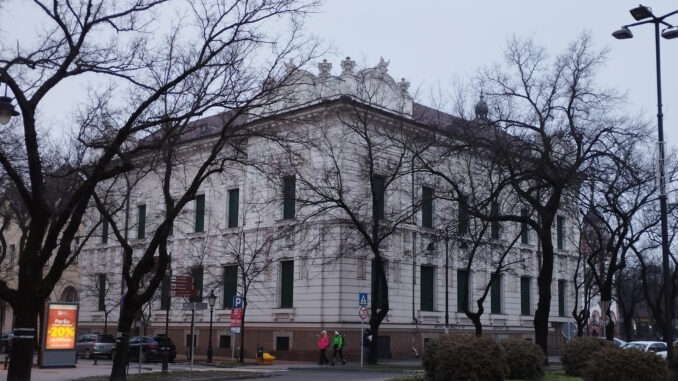
The Serbian subsidiary of the Foundation for the Preservation of Central European Built Heritage, established by the Hungarian government in 2021, bought the former Austro-Hungarian Bank building in the centre of Subotica at the end of 2021. Adjacent to the synagogue, recently renovated with the support of the Hungarian state, the foundation, run by Szijjártó’s people, now owns 25 foreign properties. None of the acquisitions have been announced in Hungary, only local databases and news reports have revealed them.
Átlátszó has already published several articles on the Central European Built Heritage Preservation Foundation (CEHH), which was registered with the court in the spring of 2021. KEÉÖMA received two (former) state-owned companies, Manevi Zrt. and Comitatus-Energia Zrt. (with total assets of HUF 15.8 billion) as a gift from the government, and the two companies already owned 4 foreign properties. Since then, through various local subsidiaries, they have bought a number of other buildings, mainly in Romania and Slovakia.
KEÉÖMA is also one of the 33 Public Interest Trusts (KEKVA) with a public service mission. This means that the state has no control over what KEÉÖMA does with the (former) public assets it has been given, nor can the state reclaim them, nor can the state dissolve the foundation if it is dissatisfied with its operations. The foundation has no website, e-mail or telephone contact.
Its leadership, as in other public property-handling foundations (KEKVA), is strongly pro-government: the Chairman of the Board of Trustees is Levente Magyar, who is also the Parliamentary State Secretary of the Ministry of Foreign Affairs and the deputy of Foreign Minister Péter Szijjártó, as well as the Ministerial Commissioner for Francophone Affairs. The members of the Board of Trustees are Péter Kiss-Parciu (Deputy State Secretary for Regional and Cross-Border Economic Development at the Ministry of Foreign Affairs), Orsolya Mária Pacsay-Tommassich (former State Secretary in charge for the Hungarian Diplomatic Academy and the Stipendium Hungaricum Programme at the Ministry of Foreign Affairs and Trade) and Gergely Jákli (former CEO of Eximbank, head of Paks II Zrt. from September 2022.) and Zsolt Virág (Ministerial Commissioner for the National Castle Renovation Programme and the National Fortress Renovation Programme 2016-2022).
Átlátszó wrote about the foundation in June last year, when it emerged that its Slovakian subsidiary had bought a castle, a Baroque mansion, a town house and a castle ruin, besides the already purchased bathhouse, monastery and other buildings.
Kastélyt és várromot is vett Szlovákiában a Szíjjártó embereivel kitömött alapítvány | atlatszo.hu
Akkor készített térképünket kiegészítettük a most kiderült, jelen cikkben szereplő új szerzeményekkel. Ezekkel és az áprilisban megvett komárnoi Poliklinikával együtt már összesen 24 ingatlanról tudunk négy országban: Szlovákiában 13, Romániában 8, Szlovéniában 2 és Horvátországban 1 van a Közép-Európai Épített Örökség Megőrzéséért Alapítvány valamelyik entitásának birtokában jelenlegi ismereteink szerint.
Expansion in Serbia
In the autumn of 2021, the Ján Kuciak Investigation Centre in Slovakia (ICJK) announced that KEÉÖMA was expanding southwards: in the spring of 2021, the Hungarian Manevi Zrt. owned by the Foundation registered its subsidiary MANEVI Real Estate Development Ltd. in Serbia.
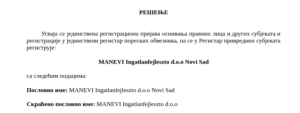
The Serbian subsidiary of Manevi Zrt. was registered in the Serbian Business Registers Agency (Agencija za privredne registre – APR) on 6 April 2021, with its registered headquarters in Novi Sad, the capital of the Autonomous Province of Vojvodina. The main activity of the company is the organisation of construction projects. Initially, its director and legal representative was Zsanett Oláh, a native of Vojvodina, who was CEO of the state-owned Hungarian National Trading House Zrt. between 2015 and 2018, then director of the Kall Ingredients Group in Tiszapüspök, Hungary, owned by Lőrinc Mészáros, and from 2021 until last September she represented Manevi Zrt. in Hungary.
From October 2022, Dr. Dénes Kővári is the CEO of the Hungarian Manevi company, and from December 2022 he is also the CEO of the Serbian Manevi company. Kővári was previously the CEO of Manevi Zrt. from December 2019 to April 2021, and earlier he worked for several other Hungarian state-owned companies. Also, he was CEO of Comitatus-Energia Zrt., another KEÉÖMA-owned company, since October 2020.
Két állami céggel négy drága külföldi ingatlant adott egy alapítványnak a kormány | atlatszo.hu
Bár a Közép-európai Épített Örökség Megőrző Alapítványról szóló törvény tavaly született, a szervezet létrejötte sokáig húzódott: alapító okirata 2021 februárjában kelt, és 2021 márciusában jegyezte be a bíróság. A Fővárosi Törvényszék bejegyző végzése azt is tartalmazza, hogy az állam összesen 15,8 milliárd forintnyi vagyont ajándékozott az alapítványnak.
Already at the end of 2021, Átlátszó found in the Serbian company database that Manevi Zrt. had increased the capital of its Serbian subsidiary, leading the newspaper to speculate that “a planned upcoming acquisition justified the capital increase”. On 19 October 2021, MANEVI Real Estate Developer Ltd. applied to increase its share capital, previously registered at 1,000 dinars (approximately 3,000 forints at the exchange rate at the time), but the application was twice rejected on formal grounds.
The application for a capital increase was finally approved on 16 November 2002, whereby Manevi Zrt. increased the assets of its Serbian subsidiary from the minimum of 1,000 dinars to 399,668,513.48 dinars (approximately EUR 3.4 million or approximately 1.2 billion forints). Átlátszó Vajdaság has found that this sum was used in the same year to purchase the first Serbian property of KEÉÖMA, which is already expanding rapidly in the Carpathian Basin.

Historic building purchased in Subotica
The building in question is located in the very centre of Subotica, less than 300 metres from the Town Hall, opposite the City Museum Subotica, adjacent to the synagogue. The building was built during the Austro-Hungarian Monarchy era, as a branch of the Austro-Hungarian Bank in Subotica in 1901, designed by the architect Ferenc Raichle J.
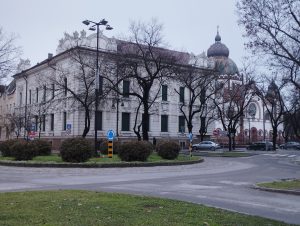
The façade of the two-storey corner building bears the hallmarks of Viennese Art Nouveau, and the decorative motifs faithfully reflect the purpose of the building. These include the mask of Mercury, god of merchants and thieves; the sunflower, symbol of wealth and abundance; the key, representing security and discretion; and the sphinx-shaped handles, suggesting that secrets are kept hidden behind these doors.

After WWI and the transfer of sovereignty the building was given to the National Bank of the Kingdom of Serbs, Croats and Slovenes in 1921. Later, in Yugoslavia after WWII, it was nationalised and transferred to the Fidelinka Bread Factory, where the management and administration were located.
Fidelinka’s property, -likewise the movable and immovable assets of most nationalised and then privatised large companies,- was sold off in a bankruptcy process, when the building, which was by then completely run down and devalued, was acquired by a Subotica-based construction company, SMB-Gradnja, which renovated the façade in 2015 in accordance with the regulations on the protection of historical monuments. However, unable to secure a more favourable parking space, the company abandoned the idea of utilizing the building.
Nearly €3 million may have been paid for the building
Although it was not publicly announced, those more familiar with the property market knew that the company would readily sell the property and that its value was estimated at €750,000. Another source in the construction industry had a similar view, saying that the former Austro-Hungarian Bank building was “a gift for €600,000 but would be expensive for €1 million”, so its real value was somewhere in between.
By comparison, the purchase price was €2.9 million.
This is reflected in the accounts of Manevi Real Estate Developer Ltd. at the end of 2021, which show that most of its assets, which were registered through capital increase, are now real estate assets. According to the accounts, which are publicly available on the Serbian Business Registers Agency (APR) website, the company has RSD 339,833,000 (approx. EUR 2.9 million or approx. HUF 1 billion) in permanent real estate assets. According to the cadastral data of the Republic Geodetic Authority, this is Manevi’s only property in Serbia.
The property is located at 15 Dimitrije Tucović Street in Subotica, on a 783 m2 plot with a 615 m2 building registered as a two-storey family house, a 7 m2 outbuilding and a 170 m2 (unbuilt) yard. A 606 m2 plot is officially registered in the cadastre, and the remaining 9 m2 is indicated by an entry from 2012, which shows that parts of the residential building are located on the adjacent plots.
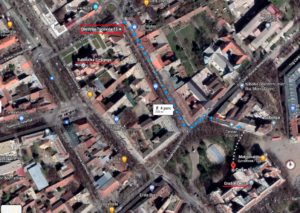
The reason for this unusual arrangement is purely administrative: the width of the public spaces, i.e. the streets surrounding the corner building, was determined in such a way that the building occupies a 16 cm wide area of the pavement along the street frontage for a length of approximately 56 metres. The building of the former Austro-Hungarian Bank was declared a monument and was entered into the cadastral register on 27 November 2012.
In its current state, the building is not ready for occupancy – at least the boarded-up windows indicate this – but it is still the only heritage property in Subotica that is in an acceptable condition and representative enough to strengthen Manevi’s portfolio.
Osztrák-Magyar Bank ART NOUVEAU
A 19. század végén Rajhl Ferenc építész részt vett az Osztrák-Magyar Bank Szabadka ágának tervezésében. 1901-ben egy szögletes, kétszintes épület épült ma Dimitri Tucović nevű utcában.
They bought their way into the synagogue garden
The Subotica Synagogue is the second largest synagogue in Europe after the Dohány Street Synagogue in Budapest. The building was designed in the Hungarian Art Nouveau style by Dezső Jakab and Marcell Komor in 1899, originally for the Jewish community of Szeged, but the jury chose another design. Some of the designs, including the Jakab-Komor plan, were put up for sale and the Jewish community of Subotica immediately bought them, and in 1902 the city’s new Art Nouveau jewel was inaugurated. The same duo also designed the Subotica Town Hall, the Palić Water Tower, the Vigadó, the Music Pavilion and the Women’s Beach, which are among the most important buildings of the Subotica Art Nouveau architectural heritage.
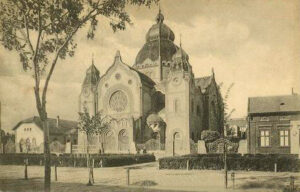
The Jewish community in Subotica – with a population of several thousand before the war – had been decimated in WWII and the returnees were no longer able to maintain the building, so in 1979 the community donated the building to the town of Subotica, hoping that the town would renovate it. From 1985 the building was used for theatre performances and concerts for a couple of years, but from 1988 the building started to deteriorate. In 1989, UNESCO recommended that it be declared a World Heritage Site. In 1990 it was listed as a building of special importance in Serbia.
For years it was listed among the ten most endangered synagogues in the world, and in 2014 it was listed among the seven most endangered buildings by the heritage organisation Europa Nostra, highlighting the need for renovation. The renovation of the building began in the early 2010s. The painted glass windows were replaced step-by-step from private donations, and the restoration of the exterior began with the support from the city budget and various grants.
The Hungarian Government supported the renovation of the Synagogue
When Prime Minister Viktor Orbán visited Subotica in March as part of his 2014 election campaign, he paid a visit to the Holocaust memorial in the courtyard of the synagogue to mark the Holocaust Memorial Year. Earlier that day, he held talks with Róbert Szabados, president of Subotica’s Jewish community, who told MTI after the visit that the Hungarian state had donated 100 million forints to renovate the interior of Subotica’s synagogue.
Then, in February 2015, Szabados announced to MTI that
the Hungarian government would support the renovation of the building’s interior with half a billion forints, five times the amount previously promised.
According to Szabados, this sum could be used to complete the renovation of the interior and the cleaning of the synagogue’s courtyard within a maximum of two years. The cost of renovating the final, northern facade was covered by the Subotica Municipality.
The support came from the Hungarian government through the Hungarian National Council (MNT), the minority self-government of the Hungarian minority in Vojvodina, which ensured that the MNT would be an indispensable factor in the continued use of the building for sacred, cultural and tourist purposes. This was decided by the Municipal Council of the Municipality of Subotica on 2 March 2015, and a tripartite agreement was signed on 25 March, stipulating that the MNT, together with the Jewish Community and the Municipality of Subotica, would be a coordinating and supervisory body of the Synagogue Foundation, would be a member of the Board of Directors of the Synagogue Foundation, and would have the right to use the building free of charge for an indefinite period, but at least 99 years.
The renovated synagogue was finally inaugurated on 26 March 2018, with Prime Minister Viktor Orbán personally attending the inauguration ceremony.
A felújított zsinagóga átadása Szabadkán. | A felújított zsinagóga átadása Szabadkán // Inauguration of the renewed synagogue in Subotica. | By Orbán Viktor | Facebook
276K views, 6.2K likes, 235 loves, 1.5K comments, 1.5K shares, Facebook Watch Videos from Orbán Viktor: A felújított zsinagóga átadása Szabadkán // Inauguration of the renewed synagogue in Subotica.
To the left of the corner building of the Austro-Hungarian Bank, which was bought by MANEVI Real Estate Development d.o.o., there is now the Jewish Community of Subotica, and to the right the synagogue, which means that, with this property, Manevi has practically bought its way into the garden of the synagogue, which was renovated with the support of the Hungarian government.
Contributed by Katalin Erdélyi Átlátszó.hu
